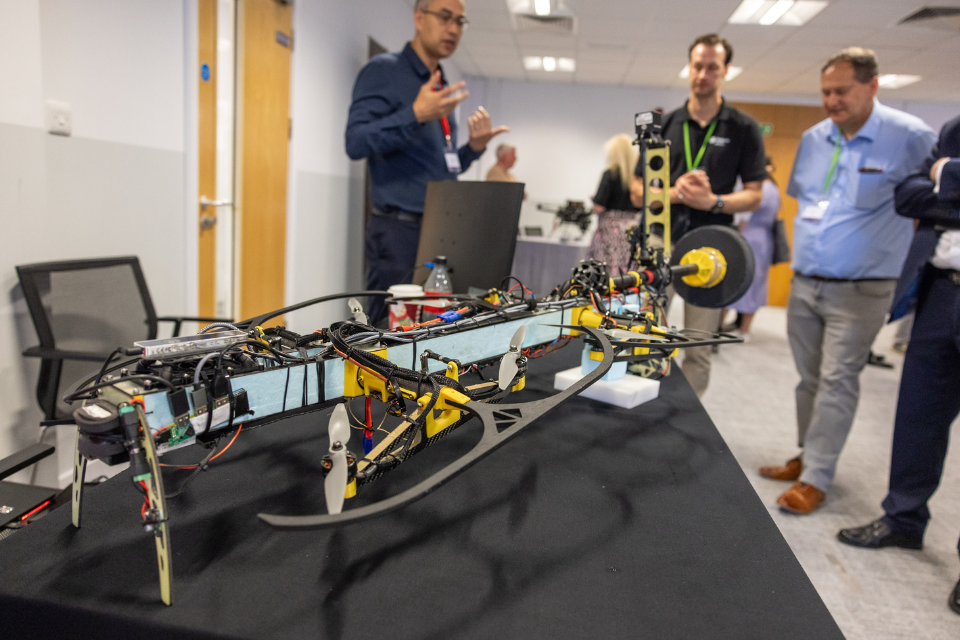Innovative nuclear site monitoring and inspection technologies showcased at demo day
DASA and the Nuclear Decommissioning Authority (NDA) hosted a demo day to showcase the progress of 10 projects funded through the Remote Monitoring of Sensitive Sites competition.

- 10 novel technologies funded through the Remote Monitoring of Sensitive Sites competition were showcased at a demonstration event held at the Satellite Applications Catapult.
- The NDA allocated £750,000 of potential funding for the competition, run by DASA, for the development of innovative, next-generation technologies to help enhance the NDA’s ability to autonomously monitor and inspect nuclear sites.
- The technologies presented at the demonstration event can add value to the nuclear decommissioning, defence and security communities by reducing risk to personnel and also increasing the efficiency of operations.
On 14 June 2023, the Defence and Security Accelerator (DASA) and the Nuclear Decommissioning Authority (NDA) held the Remote Monitoring of Sensitive Sites demonstration event at the Harwell Satellite Applications Catapult.
Various stakeholders, including those involved in nuclear decommissioning, defence, and security, as well as potential end-users, gathered to witness 10 pioneering nuclear site monitoring and inspection technologies being showcased.
These technologies were funded through the £750,000 innovation competition, Remote Monitoring of Sensitive Sites, run by DASA on behalf of the NDA.
The competition sought capability studies for innovative, next-generation technologies to underpin the remote monitoring of sensitive sites, help promote more proactive decision making, while minimising the hazards associated with carrying out risky on-site operations.
The demonstration event served as a platform for innovators to showcase their solutions for the competition’s three challenge areas and present their progress.
- Challenge 1: Built environment and infrastructure
- Challenge 2: Environmental monitoring and land use
- Challenge 3: Security and resilience
Andrew Gray, the NDA’s Innovation Delivery Manager, said:
It was exciting to see the range of innovative solutions developed for the competition, we are really pleased with the response and the interest it has generated across many different sectors. We use innovation and technology to support us in delivering our mission to clean-up the UK’s oldest nuclear sites safely, securely and sustainably. These technologies could help us to improve our decision making processes while also moving our people further away from harm and preventing them from needing to be physically present in hazardous environments.

Autonomous Devices Limited present their aerial robotic inspection tool at the demonstration event
During the demonstration event, all 10 innovators presented updates on their projects, demonstrating how they can be used to effectively monitor sensitive sites.
Earth-i Limited
Earth-i Limited’ presented an asset mapping and monitoring system that links multiple data sources, using high resolution satellite Earth Observation data combined with airborne and terrestrial data sources to provide a rich set of information layers to support NDA decision makers.
ANRA Technologies
ANRA Technologies presented their uncrewed mission manager to enable the remote management of autonomous systems for the monitoring of sensitive sites across the NDA estate.
Archangel Imaging
Archangel Imaging, a veteran-owned business, showcased its mobile, autonomous AI camera system that can be customised with specific algorithms, like vehicle or people detection, and is interoperable with other devices (e.g. drones), to monitor sites.
Lynkeos Technology Ltd
Glasgow-based Lynkeos Technology Ltd presented their structural monitoring project, which utilises muography, a technique which uses natural radiation to monitor complex structures and assess their integrity, including identifying any voids or any degradation of steel reinforcement bars. This project seeks to develop a portable muography capability for monitoring underground, ageing reinforced concrete infrastructure.
Durham University
Durham University showcased an autonomous wide-area surveillance camera to detect human and vehicle activity. Through the use of Artificial Intelligence (AI), it utilises persistent, all-condition sensing coupled with real-time algorithms for to remotely monitoring the perimeter of sensitive sites and identify unusual activity.
ISS Aerospace
ISS Aerospace presented an autonomous unmanned aerial system (UAS) with on-board real time AI processing, capable of learning their environment. The UAS is used to respond to environmental changes detected by ground based sensors which can collect data for temperature, humidity, noise, motion, and air quality.
National Physical Laboratory
National Physical Laboratory, in collaboration with Metrosol Limited and the University of Manchester, presented their novel thermometer that can replace conventional sensors in harsh environments up to 600 °C. The thermometer uses non-invasive electronic Johnson noise (electronic noise generated by thermal agitation) to measure temperature, improving reliability and reducing calibration costs.
Autonomous Devices Limited
Autonomous Devices Limited presented an update on Theia, an aerial robotic Swiss Army knife for contact based inspection, providing operators with a rapid and highly automated means of deploying sensors and cameras directly onto the most inaccessible parts of a sensitive site.
Telespazio UK Ltd
Telespazio UK Ltd presented their non-intrusive satellite based technology to monitor water related anomalies, providing early insight into risky areas, reducing the need for on-site investigations and supporting informed and timely decision-making.
Decision Lab Ltd
Decision Lab Ltd presented an update on their project which seeks to use an advanced set of competitively trained reinforcement learning AI agents, AUDI, which can improve site security and resilience through remote sensing.
Learn more about Remote Monitoring of Sensitive Sites here.